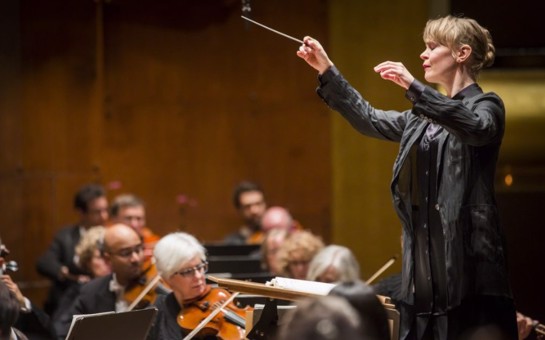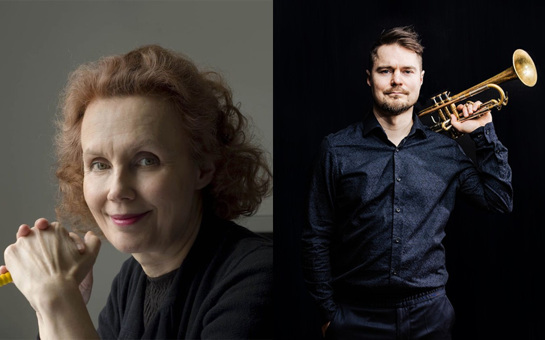- Kaija Saariaho
HUSH (2023)
(Concerto for trumpet and orchestra)- Chester Music Ltd (World)
Commissioned by Finnish Radio Symphony Orchestra, Helsinki Festival, Orchestre Philharmonique de Radio France, Los Angeles Philharmonic, Asko|Schönberg, Muziekgebouw, BBC Radio 3, Lahti Symphony Orchestra and Finnland-Institut.
Commissioner exclusivity applies
Unavailable for performance.
- tpt + 2(II:pic,afl).2+ca.2+bcl.2/4.0.0.0/timp.3perc/cel/str
- Trumpet
- 25 min
Programme Note
HUSH is written for the trumpet player Verneri Pohjola, whose rich musical background and taste for extended techniques, experimentation, and improvisation have inspired me. During the writing of this piece, we have met on a regular basis, and Verneri has enlightened me as to the technical possibilities of the trumpet. Each concerto is in a way a portrait of the soloist for whom it was written, and so this one is his.
As the solo trumpet played an important part in my violin concerto Graal Théâtre (1994), which was my first concerto, I was drawn to revisiting that material in what is to be my last concerto. I was also inspired by another kind of revisitation: Aleksi Barrière’s text Not a Knight, written in 2018 to be spoken around and inside Graal Théâtre as a form of illuminated marginalia to the music. The titles of HUSH and of its four movements come from this text, where the Grail legends resonate as a personal and collective quest of making music, and leaving an imprint into the silence.
The first movement, “Make the thin air sing”, is an exposition that presents most of the material, including the title word ‘hush’. Starting from a low A-flat, it moves upwards to the higher register.
The second movement, “Dream of falling” explores glissandi of the solo trumpet, alone and in association with various sections of the orchestra, from the piccolos to the double basses, ending with a low B growl that is one of the trumpet’s lowest sounds. (This was workshopped with Verneri improvising on the idea of a sound falling down the sides of a well.)
The third movement, “What ails you?”, is dramatic but cold, insofar that I refrained from using any accelerandi and rallentandi, and the rhythm stays strictly mechanical. This maddening rhythm was inspired by the monthly scans I underwent in MRI machines during my illness.
The last movement “Ink the silence” is an accompanied trumpet solo moving forward through an orchestral landscape. When the movement stops, we understand that it was the landscape that was moving and not the traveller, and we peek beyond the façade of illusions, into a silence that we have loaded with memories.
I am indebted to the assistance I have received from Nastaran Yazdani and Anssi Karttunen in notating music when my illness impaired my motor skills. The support of many people has been instrumental to the making of this piece, and I have dedicated individual movements to them: Verneri Pohjola, my husband Jean-Baptiste Barrière, and my doctors Dimitri Psimaras and Myriam Kirstetter. The piece in its entirety is dedicated to the family I leave behind on my own journey to silence.
Kaija Saariaho
March 2023
Scores
Features

- Kaija Saariaho’s Poetic Montages
- From the very beginning of her career as a composer, Kaija Saariaho has turned to poetry as a material and inspiration for her music. The forms and logics of poetry have played a defining role in her output since then.
Reviews
More Info

- HUSH receives its US premiere
- 30th January 2025
- Kaija Saariaho's final work 'HUSH' receives its US premiere with trumpeter Verneri Pohjola and the LA Phil conducted by Susanna Mälkki.

- UK premiere of Saariaho's HUSH
- 23rd January 2025
- Kaija Saariaho's final work, HUSH, a trumpet concerto for Verneri Pohjola, receives its UK premiere on Jan 24.

- Kaija Saariaho premieres and concerts in September in Germany and Switzerland
- 3rd September 2024
- This September, the musical world will see a lot of premieres and concerts featuring the works of Kaija Saariaho.

- World Premiere of Kaija Saariaho's final work at Helsinki Festival
- 14th August 2023
- Kaija Saariaho's final work, the trumpet concerto HUSH, is premiered by Verneri Pohjola and the Finnish Radio Symphony Orchestra at Helsinki Festival on 24 and 25 August 2023.

 Located in the UK
Located in the UK
 Located in the USA
Located in the USA
 Located in Europe
Located in Europe
